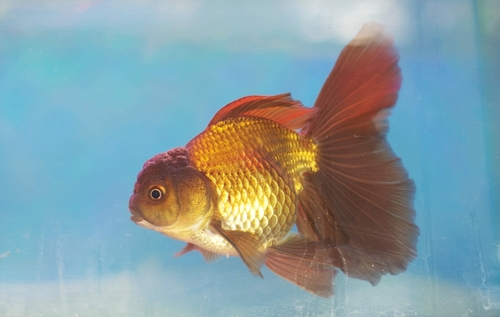Oranda goldfish are a popular type of fancy goldfish that are known for their distinctive head growths, or “wen,” which resemble a lion’s mane. They are native to China, and have been bred and kept as ornamental fish for centuries.
Generally hardy and easy to care for, they can adapt to a wide range of water conditions. That’s always going to make them a popular fish to have in a home aquarium!
Oranda goldfish come in a variety of colors, including red, orange, white, and black. They can reach sizes of up to 12 inches in length, and have a lifespan of up to 15 years with proper care.
In addition to their distinctive appearance, Oranda goldfish are also known for their intelligence and personality. They are social fish, and can be trained to respond to their owner’s commands and to perform tricks. They are also known to be curious and playful, and can often be seen swimming and playing with objects in their aquarium.
Because they are so congenial and easy to get along with, you won’t have trouble finding the best Oranda goldfish tank mates. Here is a list of the most suitable tank companions.
Contents
Oranda Goldfish 101 – What You Should Know
Temperament
Oranda goldfish are generally peaceful and docile fish that are known for their intelligence and personality. They are social fish, and can be kept with other goldfish and other peaceful aquarium inhabitants.
These fish are intelligent and playful, and can often be seen swimming and exploring their aquarium, and interacting with objects and other fish. They are also known to be trainable (like we mentioned a moment ago), and will respond to commands when they’ve been trained up.
In general, Oranda goldfish have a calm and gentle temperament, and make popular pets for aquarium enthusiasts of all ages. They are generally hardy and easy to care for, and can adapt to a wide range of water conditions.
Overall, Oranda goldfish are known for their peaceful and intelligent personalities, and can make interesting and engaging pets for aquarium owners.
Size
Oranda goldfish can grow to be quite large, reaching lengths of up to 12 inches when fully grown. However, the actual size of an Oranda goldfish will depend on several factors, including its age, diet, and living conditions.
These fish are slow-growing fish, and it can take several years for them to reach their full size. They are also prone to becoming overweight, so it is important to provide them with a balanced and nutritious diet, and to avoid overfeeding them.
In addition to their diet and age, the size of an Oranda goldfish can also be affected by the size and type of aquarium it is kept in. Oranda goldfish need plenty of space to swim and grow, and should be kept in an aquarium that is at least 30 gallons in size.
A larger aquarium will provide more space for the fish to grow and move, and can help to prevent them from becoming stunted or overweight.
Competition
These popular goldfish are almost never aggressive or territorial fish. They are peaceful and docile fish that are known for their gentle and calm temperament.
You’ll find that these are also very social fish, and can be kept with other goldfish and other peaceful aquarium tank mates.
Oranda goldfish are a good choice for home aquarium owners who are looking for peaceful and very chill fish to keep in their tank with others. It’s not hard to find fish that get along with these beautiful goldies!
Tank Setup
These goldfish are a hardy and adaptable fish, and can tolerate a wide range of water conditions. However, they do have some specific requirements and preferences when it comes to water quality and temperature.
In terms of water quality, Oranda goldfish prefer water that is clean and well-filtered, with a pH level between 6.5 and 8.0, and a hardness of 5 to 19 dGH. They are sensitive to ammonia and nitrite levels, so it is important to maintain good water quality and to regularly test and monitor the water parameters in their aquarium.
In terms of water temperature, Oranda goldfish are coldwater fish, and prefer water temperatures between 65 and 72 degrees Fahrenheit. They can tolerate a range of temperatures, but will do best in water that is consistently within this range.
Maintain these kinds of tank parameters and you’ll be all set!
12 Best Oranda Goldfish Tank Mates
Other similar posts you might like:
1. Other Goldfish

To the surprise of probably nobody, some of the best tank mates for your oranda goldfish are other goldfish!
With more than 200 different types of goldfish you can pick and choose from it’s not going to be challenging to find ideal tank mates with a ton of diversity for your oranda goldfish. Ranchu, fantail, comment, telescope, bubble eye, and lion head goldfish are all going to be exceptional fits in your oranda goldfish tank.
All of these species of fish like to school with one another and you really have to hit a patch of rough luck to get even a couple of goldfish that are aggressive towards one another. Even during the breeding season these fish generally stay pretty calm, cool, and collected.
It doesn’t hurt that they can all live in pretty much the same water conditions, too.
Pros
- You’ll never have to worry about fights breaking out amongst goldfish
- They share a lot of the same water conditions
- They school together and keep each other happy
Cons
- Picking the right goldfish from so many different options can be tough
2. Hillstream Loach
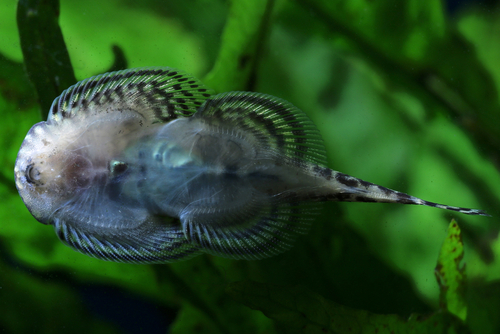
One of the more oddball tank mates you could pick for your goldfish, the hills loach looks a lot like a stingray and behaves like a pleco – but all of that helps make it a fantastic addition to your underwater world.
Even if your goldfish like to play a little rougher with these loaches than usual there’s nothing to worry about. The suction they have on your tank glass is so tight they won’t break them free!
Pros
- Plays well with others
- Lives almost exclusively in the lower section of the water column
- Likes the same conditions as your goldfish
- Keeps your tank healthy
Cons
- Can be a little tough to find nowadays
- You have to monitor their diet
3. Brochis multiradiatus
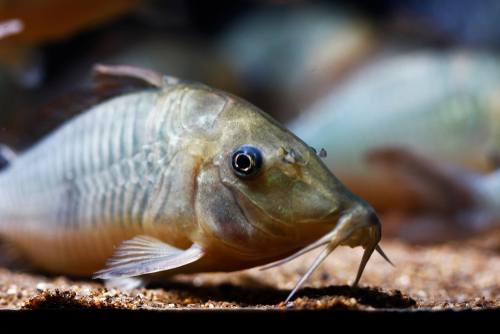
Though keeping a Cory catfish with your fish population isn’t recommended (mostly because they are tiny enough to get gobbled up by your hungry goldfish), their larger cousins that are almost identical in every way but their size are a perfect fit.
These fish can get up to 4in in length but are real gentle giants. They’ll work to keep your tank clean and your water clear and won’t give your goldfish any trouble, either.
Pros
- Are a great addition to your goldfish population
- Keep tanks clean and healthy
- Are big enough not to get eaten by your goldfish
Cons
- Don’t add a lot of liveliness to your underwater aquarium
4. Dojo Loach

Sometimes called a weather Loach, a lot of people in the home aquarium space have started to call these fish hotdogs because of the way they look.
Garbage disposals of your aquarium, these fish will eat pretty much anything and everything you can imagine. They flip around the tank, burrow deep into your substrate, and then pop out and play with your goldfish when you least expect them.
It doesn’t hurt that they are so affordable and easy to find, either. Add a couple of them to your goldfish tank and you’ll be a whole lot happier for it
Pros
- Easy to find and easy to care for
- Play well with goldfish populations
- Love to spend time in your substrate
Cons
- Sometimes not as resilient or hardy as goldfish on
5. Bristlenose Pleco
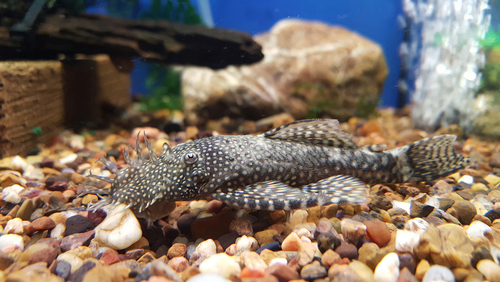
If we are being honest, some people aren’t going to love this recommendation for goldfish tank mates.
There are some in the aquarium space that feel bristle pleco will suck a goldfish slime coat off entirely, exposing your fish to some real health risks and dangers. In reality, though, this happens so infrequently (and almost only with much more massive plecos) that you don’t have a ton to worry about.
Make sure that you feed these fish later in the evening (or at night) and you won’t stir them up to the point where they might latch onto a goldfish, too.
Pros
- Super easy to care for
- Do a great job at keeping your tank clean and water healthy (especially free of algae)
- Get along nicely with all kinds of underwater creatures, including goldfish and their favorite tank mates
Cons
- Larger plecos do have a taste for goldfish slime coats and that can be risky
6. Rubbernose Pleco
You may have heard of these fish as a rubber lip pleco or as a bulldog pleco, but they are all the same creature.
These fish look a lot like bristled pleco when you get right down to it, though they do lack the barbs on the end of their noses. These plecos have a similar demand when it comes to water parameters that goldfish require, making them picture-perfect tank made.
They also have personalities that get along well with all kinds of fish, including hyperactive goldfish that like to nip and play.
Pros
- Commonly found in pretty much every fish shop on the planet
- Very affordable and easy to care for
- Fantastic playmates for goldfish
Cons
- They can produce a lot of extra waste that needs to be filtered out
7. White Cloud Minnows
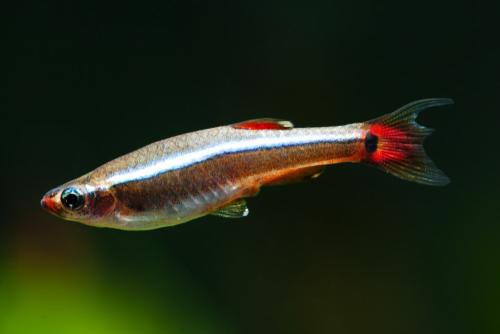
These coldwater minnows can be a great addition to your goldfish aquarium.
Just remember that you’ll need to add a couple of them into an enclosure at once as they like to be in small schools of five or 10. Luckily, these minnows are relatively small – only growing to be about 2in in length– so they aren’t going to take up a ton of aquarium space.
It’s not a bad idea to make certain that you are only ever adding mature white cloud mountain minnows into your tank, though. Younger minnows are too small and will inevitably become a snack for your goldfish or other tank mates.
Pros
- Inexpensive and easy to find
- Very easy to care for
- School up but don’t take up a lot of water
Cons
- Make sure you get mature minnows or they become goldfish snacks
8. Ricefish
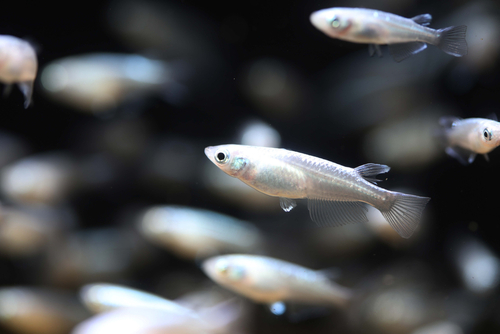
Very similar to the minnows highlighted above, rice fish will fit right in with your goldfish community, too.
These fish come in a bunch of different colors, ranging from a brilliant and shiny platinum to deep oranges and blues and everything in between. Not always the least expensive fish you can buy, you want to get a handful of these (or buy a breeding pair and hope that they reproduce) to fill out your tank.
Pros
- Very friendly to goldfish
- Beautiful and personable
- Enjoy the same water conditions as goldfish
Cons
- Will add to your bio load and increase the need for filtration
9. Hoplo Catfish

A relatively small catfish, only growing to be five or 6 inches in length), these fish play well with others – especially goldfish that have a bit of a hyperactive personality.
Just remember that these fish aren’t as nocturnal as their other catfish cousins. They are scavengers so you don’t have to target them, but you will want to make sure that they are getting enough food throughout the day all the same.
Pros
- Beautiful fish with a peaceful personality
- Friendly and calm with all kinds of tank mates
- Super easy to feed and care for
Cons
- Can get pretty big in a hurry, requiring larger tanks
10. Variatus Platy

This might look like an oddball choice for a goldfish tank made, but they are a fantastic option for those that want live-bearing fish in their aquarium.
There are all kinds of different platies to pick and choose from, in a wide variety of colors and personalities. You’re not going to have a hard time finding these kinds of fish to add to your aquarium. In fact, you might have the opposite problem – so many to pick and choose from that you have a tough time deciding!
Pros
- Easy to find and affordable
- Very easy to care for
- Will livebear and breed, keeping your tank full
Cons
- Can reproduce out of control if goldfish aren’t eating most of the fry
11. Rosy Barbs
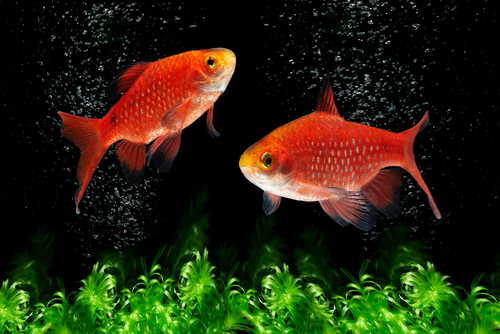
These barbs can be a little more on the docile side of things, making them a better alternative to other fish in this species family that might not have been quite as cool with your goldfish population.
Just be sure that you have a relatively decent sized school of these barbs added all at once. Too small a population makes them more aggressive.
Pros
- Hardy and easy to care for
- Beautiful and personable
- Will not attack your goldfish population
Cons
- Sometimes goldfish like to pick and nip at their longer, flowing fins and start quick fights
12. Zebra Danios
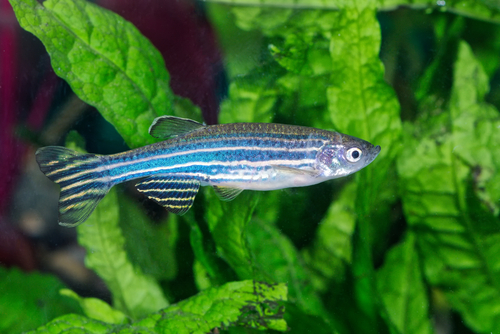
Lightning fast and downright adorable, every home aquarium should have at least a couple of zebra danios in the tank – especially if there is a goldfish population already.
Very quick (quick enough to escape bigger goldfish that might want to turn them into snacks), these fish are a fantastic contrast to your bright red and orange goldfish. Add adults and you won’t have to worry about smaller, younger danios becoming snacks.
Pros
- Fast and full of personality
- Play well with all kinds of tank mates
- Don’t require special water conditions
Cons
- Will prefer a tank with soft substrates and plenty of plantings
Closing Thoughts
A big piece of the puzzle to keeping your oranda goldfish happy and healthy is making sure they have plenty of other fish to play and pal around with.
Finding the best tank mates becomes a whole lot easier when you use the cheat sheet we provided above.
Stick to these 12 fish species and you’ll be on the fast track to success, building a diverse tank with all kinds of life all without having to worry about a bunch of fish fights breaking out!

Ian Sterling, founder of Fishlab.com, began his aquarium journey over 30 years ago, driven by a deep fascination for fish and their diverse personalities. His website, Fishlab.com, is dedicated to making fishkeeping accessible and enjoyable, offering beginner-friendly guidance, expert insights, and a community for aquarists to connect and share experiences.


